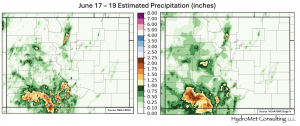Issue Date: Monday, June 20th, 2022
Issue Time: 11:25 AM MDT
Summary:
It was another active day over western Colorado and the mountains yesterday with the subtropical moisture plume pushing northward. Numerous rounds of storms fired throughout the day over the mountains, favoring areas west versus east, with the San Juan Mountains again cashing in on some significant totals. Gridded QPE looks like it’s underestimating totals over this area again this morning with a handful of SNOTEL stations over the San Juan Mountains recording over an inch of rainfall. More on that below. A MesoWest station along Highway 140 near the southern border picked up 0.93 inches for the 24-hour period and had a severe thunderstorm pass overhead in the afternoon. One-hour totals at the gauge were around 0.4 inches. The severe storm, that occurred just before 3:30PM MDT, also produced large hail that was estimated between 1.5 and 2 inches in diameter. For reference, that’s about the same size as a ping pong ball to a lime! There were a couple other severe thunderstorms over the Southwest Slope during the afternoon hours that developed due to breaks in the cloud cover that produced meaningful rainfall, a lot of hail and wind gusts up to 60 mph. The storm near Mesa Verde covered the ground in up to 6 inches of hail!
Further north, over the Grand Valley, storms were more isolated and 24-hour QPE was around 0.60 inches of rainfall for the Roan Cliffs. Highest observation in the area was 0.25 inches northwest of Rifle. More wind was also reported further north due to the lack of surface moisture and a 64 mph gust was recorded outside Meeker at 2:25PM MDT.
Another area that saw significant rainfall yesterday were the southwest facing slopes of the Southeast Mountains. A CoCoRaHS station just south of the Great Sand Dunes saw another 0.50 inches of rainfall bringing its 3-day total to 1.27 inches. MRMS QPE reached up to 1.3 inches for this area yesterday. Even the San Luis Valley got in on the action again with 0.16 inches recorded in Monte Vista, 0.24 inches near La Jara and around a quarter of an inch in the interior valley near Alamosa.
Over the Front Range, a Flash Flood Warning was issued for the Cameron Peak burn area at 2:40PM MDT. Gridded QPE estimates were around or just over 0.50 inches, which seems in line with a 0.39 observation north of Estes Park. As of this morning, there was no flooding reported. As storms pushed into the adjacent eastern plains, very little rainfall was observed for the I-25 corridor (under 0.20 inches), but some higher totals up to 0.5 inches were realized over the Southeast Plains and Palmer Ridge. Highest observation was a CoCoRaHS station in western Las Animas County that recorded 0.48 inches.
Rainfall Recap:
As mentioned in the previous SPM posts, QPE has been underestimated over southwest Colorado during this last event when compared to observations. Below is the estimated precipitation from June 17 to June 19th using two other gridded data sets, MRMS (left) and Stage IV (right). MRMS estimates up to 2.5 inches of rainfall falling over pockets of the San Juan Mountains, while Stage IV has widespread totals between 2 and 2.25 inches. For comparison, you can look at the 72-hour QPE in MetStorm below. If you add in SNOTEL stations, for the 3-day rainy period, the Middle Creek and Weminuche Creek sites recorded 2.8 and 2.9 inches, respectively, showing the QPE underestimations and indicating that MRMS likely did the best of the 3 QPE data sets for this region. Here’s another example. A CoCoRaHS station near the Mineral and Archuleta county line (9 miles NNW of Pagosa Springs) recorded 2.12 inches for the duration of the event. The gridded QPE shows only 1.36 inches for MRMS and 1 inch for Stage IV.
If I’ve convinced you that MRMS is the superior data set for estimating rainfall during this last event, think again! It looks like MRMS missed the higher rainfall totals over the north-central Gunnison County that occurred over the West Elk Mountains. The SNOTEL sites in the area, Schofield Pass and Upper Taylor, recorded 1.4 and 1.6 inches (respectively) for the 3-day period. The takeaway from all of this? No one gridded QPE data set is perfect, which is why the SPM tracks rainfall observations whenever it’s possible. Followers of the SPM in more rural areas, please sign up for CoCoRaHS!
With all this widespread rainfall over the last few days, it’s not surprising that there have been streamflow rises on rivers and streams over southwest Colorado. There has been no flooding reported on any of the major rivers, but it is likely local streams and creeks are still running high this morning. Here’s a nice downstream response to all the rainfall along the Rio Grande near Del Norte. This is quite a significant response on a major river with an estimated ~550cfs jump in flow! Expect all flows to start to drop over the next 12 hours with no more rainfall in the forecast.
As of the time of this post, there has been no flooding reported. For precipitation estimates from MetStorm over your neighborhood yesterday and over the last 72-hours, scroll down to the precipitation map below.


